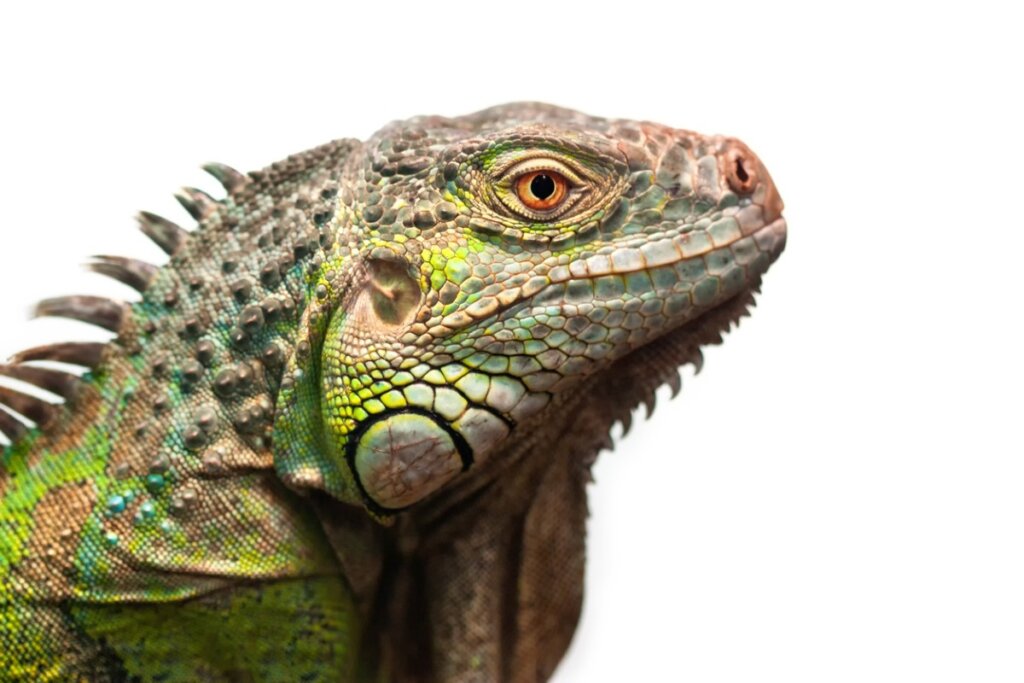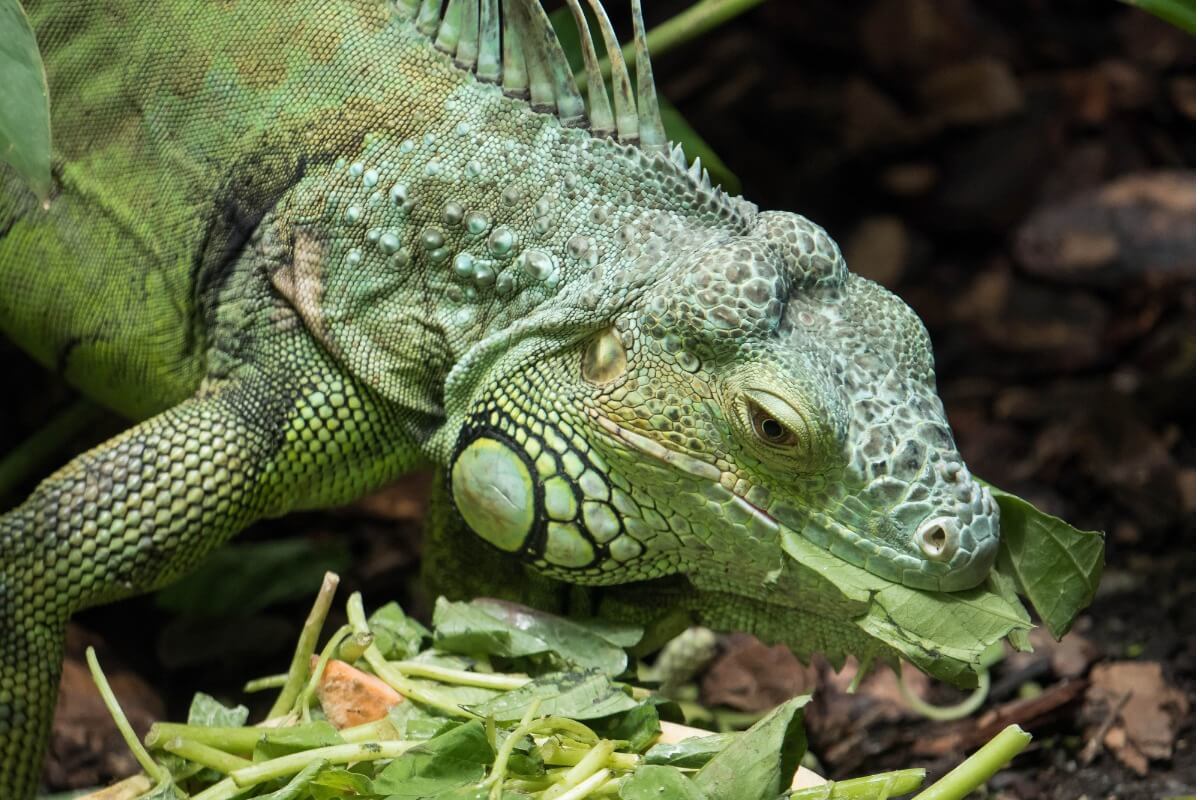The 12 Most Common Diseases in Iguanas

Iguanas are docile, peaceful animals, which makes them excellent pets for reptile fans. However, to keep them in captivity, they need to have enough space and ideal conditions. Otherwise, they may be susceptible to some of the most common diseases in iguanas.
This reptile is usually easy to care for if its basic needs are met. However, this doesn’t make them immune to suffering from different diseases, which can put their health and life at risk. Continue reading this space and find out which are the most common diseases in iguanas.
Factors that can cause diseases in iguanas
Most diseases in iguanas are caused by neglecting their habitat. Fortunately, the factors that cause these diseases can be easily prevented. The most common causes that affect this reptile’s health are the following:
- Habitat conditions: Iguanas need a correct habitat to have the right conditions to survive. When parameters such as temperature, light, substrate, humidity, or decoration aren’t adequate, the specimen becomes more sensitive to diseases.
- Diet: Nutrition can either benefit or harm an animal’s health and body, and the strength of its immune system depends on it. Keep in mind that a diet for herbivores should be quite varied, as this helps the reptile get everything it needs from its food.
- Hygiene: This reptile spends its entire life inside the terrarium, so it soils the place regularly. This creates a perfect place for bacteria and fungus to grow. As a result, this can lead to infections, and so you’ll need to clean the iguana’s living space often.
- Accidents: Any physical harm to your pet iguana could cause them health problems. Therefore, to avoid more serious problems, it’s best to take it to the vet to get it treated immediately.

What are the most common diseases in iguanas?
Although there’s a wide variety of diseases that can affect this reptile, some of them are more common than others. In fact, many of them are easy to cure, but you’ll need to visit a veterinarian to get a proper diagnosis. Listed below are some of the diseases that can affect iguanas.
1. Metabolic bone disease
This is a complex disease that affects several types of reptiles and is caused by a deficiency of vitamin D and calcium. As a result, the specimen will have a demineralization of the bones, which increases the likelihood of them breaking and becoming deformed. To prevent this, a diet with calcium-rich vegetables and good lighting (UVA and UVB) should be provided, as the synthesis of vitamin D depends on it.
2. Intestinal impaction
Some species of iguanas may have certain problems with their substrate, as they can easily ingest it by accident. Having gravel, sand, or sawdust in their habitat could cause serious complications for their digestive system. The most serious condition is intestinal impaction, an obstruction of the intestine due to the ingestion of the substrate.
It’s important to note that this doesn’t happen with all species, as some desert specimens need to have sand as a substrate. For example, if the iguana has the habit of digging, it’s very likely that it won’t develop this complication.
3. Dysecdysis
Dysecdysis refers to the problems that reptiles have during molting, which causes certain parts of the body to become caked in dead skin. This is usually caused by a lack of moisture in the environment, but is also caused by parasitosis and other ailments. The areas most affected are the extremities (such as toes and feet).
Although it may not seem so serious, dead skin can cause a tourniquet effect, which prevents circulation to the extremities. If this extra skin isn’t removed, the animal may lose its feet or toes. The most obvious signs of dysecdysis are the presence of opaque or whitish patches on the reptile’s skin.
4. Egg retention (dystocia)
Dystocia is a very common complication in captive reptiles. It’s caused by the inability of the captive female to oviposit (give birth) to her young. As a result, the iguana’s eggs become trapped in the oviduct, which causes a series of conflicts with its internal organs.
It’s normal to assume that this only happens to mating specimens. However, iguanas can still lay infertile eggs despite not having a mate. Therefore, any female iguana will be susceptible to this problem if you’re not careful. The most obvious symptom of dystocia is a widening of the abdomen.
5. Abscesses
Abscesses are usually caused by bacteria that infect the superficial wounds of the reptile’s skin. To combat this, the pet’s body forms a kind of capsule or inflammation that is quite evident. This type of laceration should be removed by a professional, as the infection can worsen if you’re not careful.
Any wound is capable of producing an abscess.
6. Urinary problems
It’s very common for iguanas to have urinary problems and, in many cases, they’re a consequence of a bad diet. The most common example is bladder stones (urolithiasis), which cause obstruction, pain and discomfort. One of the most recurrent symptoms is blood in the urine. It’s always best to see a veterinarian to confirm the diagnosis.
7. Fungal infections
This reptile’s habitat is humid and with high temperatures, a perfect environment for some types of pathogens to grow. For this reason, infectious agents such as fungi will start to affect the reptile if it isn’t cleaned regularly. However, fungal infections are opportunistic diseases that only affect the pet when it’s weak.
Symptoms can be varied, as the pathologies that cause these infections are diverse. Among the most common are dermatitis and fungal pneumonia, which require treatment with antifungal drugs for quite long periods of time.
8. Internal parasites (endoparasites)
Internal parasites infect the pet through food, especially when the vegetables it eats aren’t cleaned properly. These organisms affect the reptile’s digestive system and cause gastrointestinal problems, bad smells, and loss of appetite. Some of the causes are tapeworms, nematodes, intestinal worms, and protozoa.
9. External parasites (ectoparasites)
Parasites of this type are characterized by how they invade an iguana’s skin and produce a series of desquamations (skin peeling) and dermatitis that create discomfort. A common example is the mite, an invertebrate that feeds on the pet’s blood. The most common symptom of parasitism is intense itching, which causes the animal to rub against walls and other surfaces in its habitat.
10. Paralysis of the hind limbs
Paralysis of the hind limbs is caused by a deficiency of vitamin B1, which prevents the iguana’s body from moving easily. The etiology is based on an inadequate diet. The treatment for this paralysis is the use of vitamin supplements, which must be prescribed by a veterinarian.
11. Respiratory diseases
The lack of temperature and ventilation often causes respiratory diseases in iguanas. Bacteria are usually the microorganisms responsible for these diseases, but some viruses and fungi can also cause the same problems. Some of the symptoms are the presence of nasal secretions and difficulty breathing.
To avoid these infections it’s necessary to keep the habitat in optimal conditions and have excellent ventilation. This will prevent the air from becoming crowded inside the pet’s home, which prevents the growth of bacteria and other pathogens.
Remember to constantly clean the iguana’s living space, because any leftover food or dirt are sources of infection that could lead to the illness.
12. Hypercalcemia (metastatic mineralization syndrome)
Although it sounds counterintuitive, iguanas can be harmed by too much calcium in their diet. If their organs store this mineral, some structures begin to calcify and the situation can lead to a fatal scenario. The symptoms of this pathology are quite vague and not very specific, so it isn’t usually easy to detect.

The best recommendation is that, on seeing any change in the iguana’s behavior, you immediately go to the vet. Remember that it isn’t always possible to diagnose the reptile in time, so it’s best to have routine appointments with the specialist in order to give your iguana the best possible care. Keep in mind that most of the pathologies are caused by the carelessness of the owner, so don’t forget to be ever watchful.
All cited sources were thoroughly reviewed by our team to ensure their quality, reliability, currency, and validity. The bibliography of this article was considered reliable and of academic or scientific accuracy.
- Galvis Ramírez, A. L. (2019). Neumonía fúngica en iguana verde (Iguana Iguana) alojada en el Centro de Recepción de Fauna Temporal de la ciudad de Bogotá.
- Aguilar, J. Z. SUSTENTABILIDAD DE LA UMA DE IGUANA VERDE (Iguana iguana)“LA HUELLA”, CHIAPA DE CORZO, CHIAPAS. Estudios sobre la fauna silvestre de México y las interacciones humano-animal, 186.
- Barten, S. L. (1993). The medical care of iguanas and other common pet lizards. Veterinary Clinics of North America: Small Animal Practice, 23(6), 1213-1249.
- West Hartford, C. T. (2002) Calcium-related Pathologies in Green Iguanas. Iguana Times, 9(1), 35-37.
- Frye, F. F. (1997). The importance of calcium in relation to phosphorus, especially in folivorous reptiles. Proceedings of the Nutrition Society, 56(3), 1105-1117.
